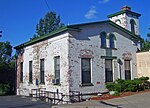Dana Park
Parks in Albany, New YorkUrban public parks

Dana Park is a small .2-acre (810 m2) urban park in Albany, New York and includes a memorial to James Dana which doubles as Albany's last remaining horse trough. It is located in the Y-intersection caused by Delaware Avenue to the east and Lark Street to the west, with the third leg of the triangle formed by Dana Avenue. Madison Avenue forms a five-point intersection with Lark Street and Delaware Avenue at the eastern end of the park. The park is important to several different neighborhoods, Hudson-Park, Park South, and Lark Street.
Excerpt from the Wikipedia article Dana Park (License: CC BY-SA 3.0, Authors, Images).Dana Park
Delaware Avenue, City of Albany
Geographical coordinates (GPS) Address Nearby Places Show on map
Geographical coordinates (GPS)
| Latitude | Longitude |
|---|---|
| N 42.651972222222 ° | E -73.768 ° |
Address
Delaware Avenue 13
12210 City of Albany
New York, United States
Open on Google Maps










